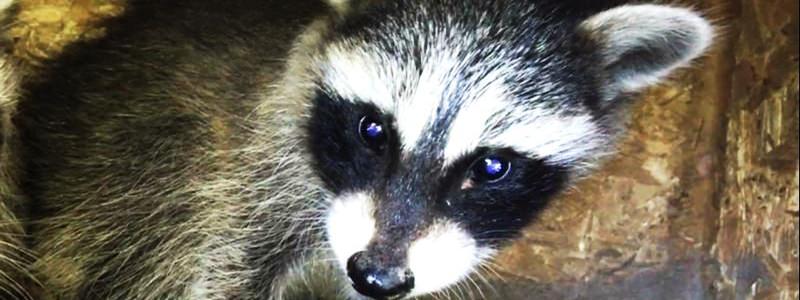
Do You Need Raccoon Removal? The 10 Top Signs Raccoons Are Living In Your Attic
Posted by Jared Houliston Friday, February 17th, 2017 | 16,780 Reads
These are the top 10 signs you have raccoons living in your attic which will tell you if you need raccoon removal services.
Between January and May we get an increase in calls from home owners complaining about loud noises coming from their attic. In these cases, 99% of the time there’s a raccoon in the attic that’s going to need to be removed promptly. If it’s not removed, attic damage will be the likely result.
What about cases when you don’t hear thumping noises? How do you know if you have a raccoon problem before it’s too late? Read our top ten list of signs that one or more raccoons are living in your attic, so you can have them removed before the attic damage gets worse.
Quick Reference
Loud noises and thumping sounds coming from your attic are usually the first signs that alert home owners. If you hear those sounds, combined with this list, you have a raccoon living in your attic.
- Melted snow patches on your roof
- Experiencing electrical issues
- Holes on your roof
- Damaged soffit or fascia
- Heating and air conditioning issues
- Urine and feces in your attic
- Moisture stains on your ceiling
- Damage to parts of your property
- Raccoon footprints in the winter
- Strong smells and odours
If you see any of the signs above, get a quick quote for an attic inspection for raccoons, so you can get them removed as soon as possible.
Detailed Explanation of Each Point
#1. Melted snow patches on your roof
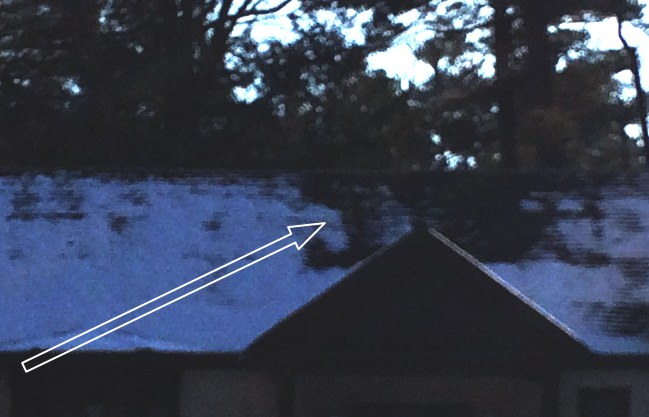 When it snows, if you look at your roof and see parts of it with melted snow, there’s potentially an air circulation issue in your attic . This may been caused by raccoon damage.
When it snows, if you look at your roof and see parts of it with melted snow, there’s potentially an air circulation issue in your attic . This may been caused by raccoon damage.
In a healthy attic, there is proper air circulation, so the snow on your roof will melt evenly. If not, heat is escaping from the inside of your home. This is due to either poor air circulation issues and damaged insulation.
This doesn’t necessarily mean that raccoons or other forms of wildlife are living in your attic, but it’s definitely a reason to investigate further. It could mean that there were raccoons living in your attic in the past, and your attic is now damaged. It could also mean there’s a large hole in your roof somewhere.
#2. You experience electrical issues
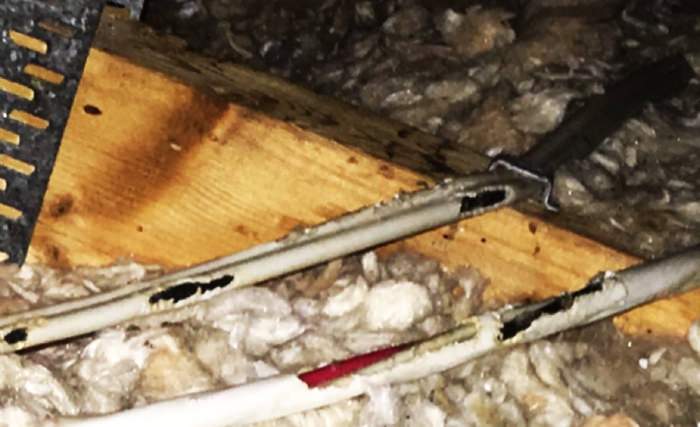 Raccoons like to get into everything. One major problem for home owners are electrical issues caused by raccoons that like to chew wires
Raccoons like to get into everything. One major problem for home owners are electrical issues caused by raccoons that like to chew wires
Adolescent raccoons that are curious and teething, tend to chew on anything that soothes their aching gums.
If the wires in your attic become chewed, you’ll start experiencing occasional light-flickering in your home. Electrical outlets may stop working and there’s a potential for fires.
#3. Holes on your roof
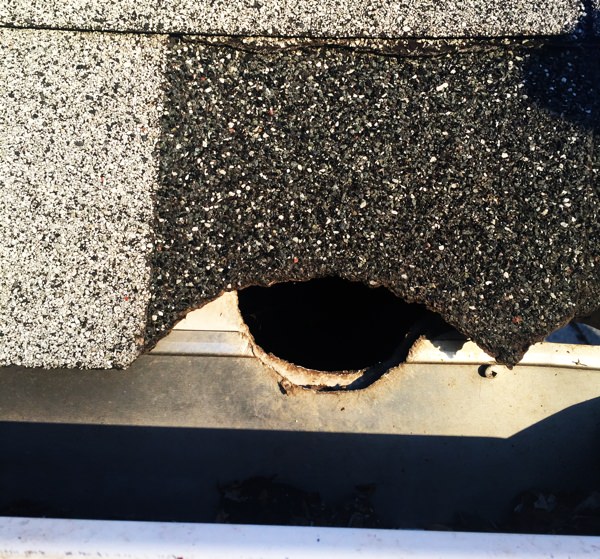 It is a good idea to inspect your roof from time to time to make sure there are no holes that could be used as raccoon entry points.
It is a good idea to inspect your roof from time to time to make sure there are no holes that could be used as raccoon entry points.
Holes that are left unchecked are perfect entry points for raccoons and squirrels. If they happen to find a hole, they will use it to gain entry to your attic.
A hole on your roof can be caused by two things: 1. weather damage, or 2. a raccoon or squirrel entry. Since houses are made to withstand harsh weather, it’s probable that the hole was created by a wild animal.
Leaving your roof unchecked for holes and other damage is basically the same as inviting raccoons into your attic.
#4. Damaged soffit or fascia
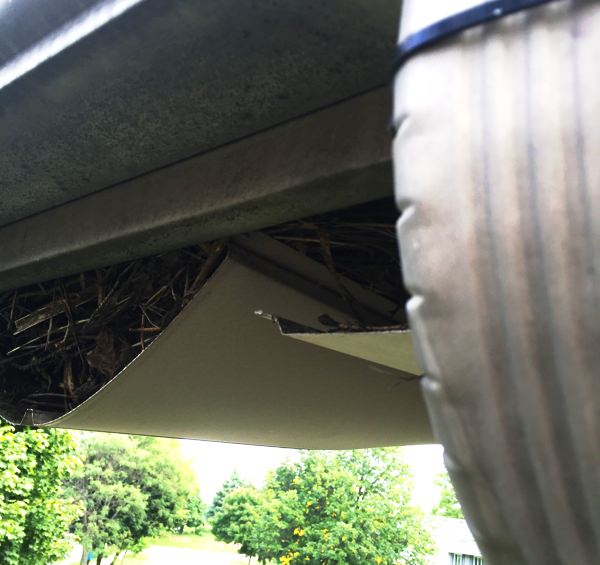 If your home’s soffit or fascia is damaged you can assume there are raccoons or other animals in your attic. There’s virtually no other reason for soffit or fascia damage, save occasional ice damage.
If your home’s soffit or fascia is damaged you can assume there are raccoons or other animals in your attic. There’s virtually no other reason for soffit or fascia damage, save occasional ice damage.
If your fascia or soffits are damage, you’ll need attic and roof repairs from wildlife damage.
Raccoons are very strong and find it easy to rip open a soffit board, or chew around your fascia in an attempt to get into your attic.
It’s easy to find soffit damage by walking around your home and looking up for any signs. Any issue you find should be considered an entry point even if there’s only a small crack.
Raccoons don’t need big holes to get into a home, so soffit and fascia damage should never be overlooked. It’s likely that a family of raccoons has been using it to get into your attic for several months.
#5. Heating and air conditioning issues
Raccoons and other forms of wildlife inevitably mess up the balance of the insulation in your attic. This can result in major heat losses in the winter, cool-air losses in the summer. If your attic insulation has been destroyed, the air in your attic won’t circulate properly. When this happens heating and air conditioning bills don’t make sense. Most people chalk it up to over-use or even blame the energy companies for over-charging.
Damaged insulation accounts for significant heating and air-conditioning problems. If your home is not maintaining the temperature the thermostat claims, take a look in your attic for signs of raccoons. If you do see evidence of raccoons, make sure to call your local pest control company promptly.
#6. Seeing urine and feces in your attic
Seeing urine and feces stains in your attic is a major sign you have raccoons. Raccoons leave droppings and urinate away from their nest, where it starts to build up. If they have lived in your attic long enough, you’ll start seeing urine stains coming through your ceiling.
Raccoon fecal matter and urine carry potentially harmful bacteria like round-worm and Hantavirus. Both of these can be transmitted to humans and pets. Although it is rare for humans to contract these diseases from raccoons, it has happened.
The best advice is to stay away from of any fecal matter or urine, and just call the professionals to clean your attic for you. Most pest control companies will remove the debris left by wildlife, and restore your attic to it’s original condition.
DID YOU KNOW? 80% of all raccoon droppings contain eggs for roundworm (Baylisascaris procyonis) which is quite dangerous if contracted by humans.
#7. Moisture stains on your ceiling
If a raccoon has chewed out a hole in your roof, your attic is going to be exposed to the elements, and moisture will start leaking in. The insulation in your attic will absorb a lot of the moisture at first but eventually it becomes too much and the water stains start coming through your ceiling.
Holes in your roof caused by raccoons can cause your attic to flood. A flooded attic can destroy everything in your attic including belongings, attic insulation, your drywall and can degrade the entire structure of your attic in general.
Am unchecked—raccoon sized hole on your roof—can end up costing you thousands of dollars in attic repairs. Just imagine what months of unwanted buildup can do. If you see stains on your ceiling, don’t ignore this sign. Look in your attic for raccoons but make sure to call the experts if you see one.
#8. Damage to parts of your property
If there’s a raccoon in your attic you’re going to see signs around your property. You’ll see damaged garbage bins, ripped garbage bags, and holes on your roof. Raccoons have a lot of strength. They can damage down spouts, rip open eavestroughs, chew through shingles, and destroy air vents. You may also see garbage scattered all over your yard or driveway.
Raccoons will damage bird feeders, dig up your garden, eat your vegetables, and pull up sod. If you see this type of damage on the outside of your home, call a raccoon removal company to arrange for a thorough inspection.
#9. Raccoon footprints in the winter
A good thing about the winter is that you can spot raccoon and squirrel tracks quite easily. If a raccoon is going in and out of your attic you will eventually notice the foot prints around your home and on your roof.
Raccoons start mating in January which is typically when you’ll see their footprints as they go out foraging for food for themselves and their babies.
If you see raccoon tracks around your home, and the other signs mentioned here, it’s likely raccoon are in your attic and that you should call the experts immediately.
#10. Strong smells and odours
One of the biggest signs raccoons are in your attic are strong odours that make it into your living area. These odours are caused by a build up of moisture, fecal matter and urine. They can also be caused by the dead animal remains, rotting food, and debris brought in from the outside.
These odours eventually make it into common if they’re left there for months or years without anything being done about it. Raccoons don’t actually leave their den to relieve themselves so there’s eventually going to be a buildup.
The take home
Go through this checklist to find out if you have any signs of raccoons in your attic, and stay safe. Your objective is to find out if you have raccoons, not to encounter or make friends with them. If you do discover you’re harbouring raccoons in your attic, call the raccoon removal professionals immediately.
Ontario Wildlife Removal Inc. provides wildlife removal and pest control in Southwestern Ontario, including Brantford, Kitchener-Waterloo, Cambridge, Guelph, London, Woodstock, Tillsonburg, Simcoe, Port Dover, Paris, St. George, Six Nations, Caledonia, Burlington, Waterdown, Oakville, Hamilton, Stoney Creek, Grimsby, & Niagara Region. Our methods are safe, humane and environmentally friendly. Call today to book your inspection.
Get a Pest Control Quote
Simply fill in your details below and we'll call you very shortly to discuss your issues.





Leave a Reply